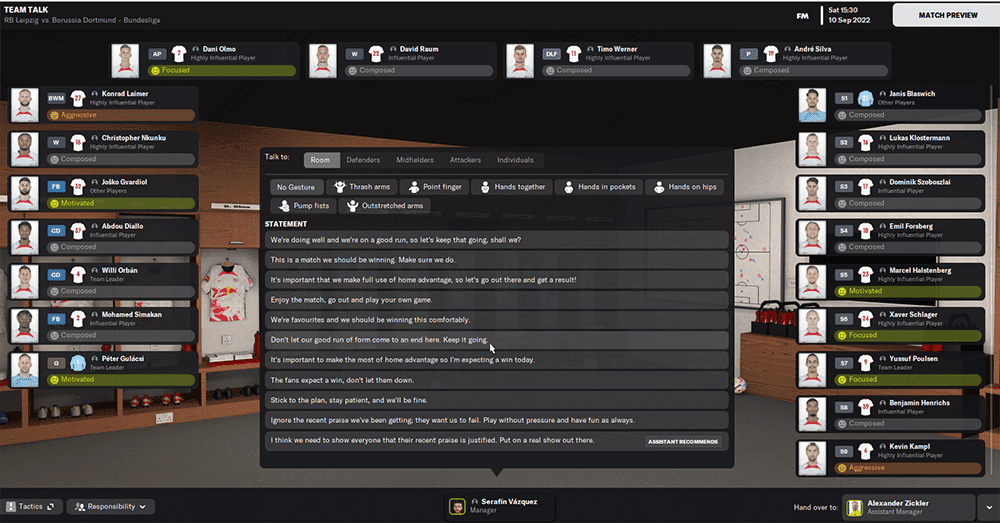A list of four methods that could force a comeback in a game that may appear lost in Football Manager. Become the FM comeback king.
Mastering the Comeback: Strategies to Reverse Your Fortunes in Football
Manager
There is an art to turning a game around in Football Manager. When it looks like you’re about to be on the wrong end of an embarrassing result, a truly great manager knows how to turn the game on its head and save face. So, if you find yourself staring down the barrel of a home defeat to a lower league side or 2-0 down in a cup final as you chase your club’s first silverware, look no further as we guide you through clawing back your side’s dignity. For a deep dive into scouting the best talent to strengthen your squad for these exact scenarios, don't miss out on our Football Manager scouting guide and tips.
1. Unlock Space and Creativity to Turn the Tide
Create more space on the pitch, and therefore your chances of creating chances, by increasing your team’s fluidity and encouraging more expressive football. This is especially important when facing an underdog, as you may well find they’ll drop back and try to preserve their unexpected advantage. You’ll need to break down their defence, and that requires fluidity.
Tinker with your shape to support your attack, and try adding instructions such as be more expressive. This gives your players a better license to react to the game in front of them and sneak a chance against the run of play. Personally, I like to add dribble less as well; the ball moves quicker than players, and asking them to pass the ball rather than dribble forces your players to move off the ball and drag the defence out of position.
2. Changing Player Roles
If you have a favoured formation on Football Manager, then it may be worth
altering players’ roles to allow players to be more creative and more
settled playing in ways that are more familiar to them instead of following
their manager’s philosophy. Check your players’ individual preferred roles,
and – where appropriate – make these changes on the pitch. For instance, you
may want to change your wide players to inside forwards, and your wide
defenders to wing backs, or even complete wingbacks.
READ ALSO: Unlocking Deep Defences in Football Manager
3. Smart Substitutions: Timing and Strategy
Although it may be painfully obvious to acknowledge substitutions as an effective way of changing the game in football manager, it is important to use them in the right way. Check both your own and your opponents’ stats; if one of your players isn’t playing effectively - for instance one of your wide players isn’t getting enough crosses in - cross-reference his attributes with the opposing player on the other team. You may notice that they have stronger attributes, in which case you will want to exploit their mental and physical tiredness by introducing a player with higher Creativity, Determination, Pace, Acceleration or Strength.
However, there’s always the opportunity to attack a weakness here as well.
For example, if the opposition full-back who’s so far keeping your inverted
winger out of the game isn’t blessed with pace, get your fastest winger on
that side and tell him to dribble more. You’ll run rings around the
opposition and find a brand new avenue to attack.
Use substitutes sparingly. The most effective time to make these changes is between the 60th and 70th minutes of a game - the perfect time to introduce some fresh new legs.
Use substitutes sparingly. The most effective time to make these changes is between the 60th and 70th minutes of a game - the perfect time to introduce some fresh new legs.
READ ALSO: Mastering the Margins: A Tactical Guide to Matchday Success in Football
Manager
The half-time team talk can be the most decisive factor in turning a loss
into a win. With the right motivating, any team can battle back into
contention. When combined with a group of players with a high determination
stat, a team talk that appeals to your team’s desire to win can have
extremely positive results.
Try to win their attention by using a passionate or assertive body language, and by using a dialogue option that addresses their apparent lack of desire to win, or emphasise that each player can make a difference to the outcome of the match. In some circumstances, outright anger might even be the shock they need to snap out of whatever stupor they’ve found themselves in.
You don’t have to wait for half time to motivate your players though. Many a time I’ve conceded 2 goals in the first 10 minutes, throwing my gameplan out the window. The first thing I do is use a touchline shout to berate my players. They’ve let me down and deserve to know it, and this almost always brings them crashing back down to earth. This is a two-way street, though; if they manage to claw back some dignity with a couple of goals, I always make sure to encourage or praise them in the same way. This reminds the players they’re on the right track, and motivates them to keep working.
4. Motivate Like a Pro: Team Talks and Beyond
Try to win their attention by using a passionate or assertive body language, and by using a dialogue option that addresses their apparent lack of desire to win, or emphasise that each player can make a difference to the outcome of the match. In some circumstances, outright anger might even be the shock they need to snap out of whatever stupor they’ve found themselves in.
You don’t have to wait for half time to motivate your players though. Many a time I’ve conceded 2 goals in the first 10 minutes, throwing my gameplan out the window. The first thing I do is use a touchline shout to berate my players. They’ve let me down and deserve to know it, and this almost always brings them crashing back down to earth. This is a two-way street, though; if they manage to claw back some dignity with a couple of goals, I always make sure to encourage or praise them in the same way. This reminds the players they’re on the right track, and motivates them to keep working.
READ ALSO:
Mastering Team Talks in Football Manager
No one likes to find themselves in need of a comeback. While we think of famous comebacks, like Liverpool in Istanbul in 2005, we as fans love the drama; but I’m sure Rafa Benitez would’ve preferred a more straightforward match. Sadly, we don’t always get that, and we need to recover from deficits we’d rather avoid. Hopefully, using this guide, you’ll be able to conquer your challenges and complete your comeback.
Conclusion
No one likes to find themselves in need of a comeback. While we think of famous comebacks, like Liverpool in Istanbul in 2005, we as fans love the drama; but I’m sure Rafa Benitez would’ve preferred a more straightforward match. Sadly, we don’t always get that, and we need to recover from deficits we’d rather avoid. Hopefully, using this guide, you’ll be able to conquer your challenges and complete your comeback.

















